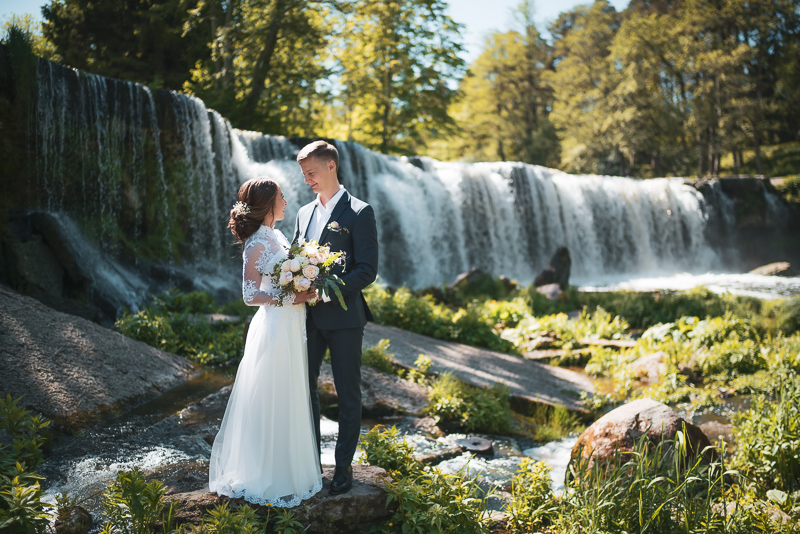
35mm is a very popular focal length with a wide range of applications ranging from landscape over astrophotography to environmental portraiture and many consider it the best choice when only using one prime lens. We decided to summarize our experience with all the native E-mount and a few legacy 35mm lenses for the Sony A7 series to give you a compact and independent resource for choosing the best 35mm lens for your needs.
We also have a general guide to FE-lenses, 9-18mm ultra wide angle lenses, guide to 20-28mm wide angle lenses, 50mm lenses, 85-200mm portrait lenses and macro lenses.
Unlike most other review sites we have no association with any lens manufacturer apart from occasionally loaning a lens for a review. We prefer independence over fancy trips and nice meals.
Before any short introduction we tell you how long we have used a lens and if we have borrowed it from a manufacturer. But in most cases we have bought the lenses new from retail stores or on the used market. If you want to support our independent reviews please consider using one of the affiliate links. It doesn’t cost you anything and helps us a lot.
If we have left any question unanswered please leave a comment or contact us on social media and we will do our best to answer it.
Last update: March 2025, cleaned up a bit
Contents
5 Questions to consider before deciding on a 35mm lens
There is no best 35mm lens for everyone, since individual needs are so different. This is why you won’t find any ratings in terms of stars or points out of 5 in this guide. Instead here are 5 questions to help you reflect on what you need in a 35mm lens. If you already know what you need you can skip to the lenses discussion directly.
1. What will you use your 35mm lens for?
A lens might perform very well for one application and fail for others. The Zeiss Loxia 2/35 for example is a favorite of many landscape photographers but we can only recommend against using it for a wedding. Our favorite wedding lens, the Sigma 1.2/35, on the other hand is a behemoth of a lens you probably don’t want to carry on a longer hike. Other lenses like the Sony FE 1.8/35 aren’t the best in any category but cover a wide range of applications well enough. So before deciding on a lens you should ask yourself what you want to use your lens for. Here we present a few scenarios to make it clearer what aspects matter for those.
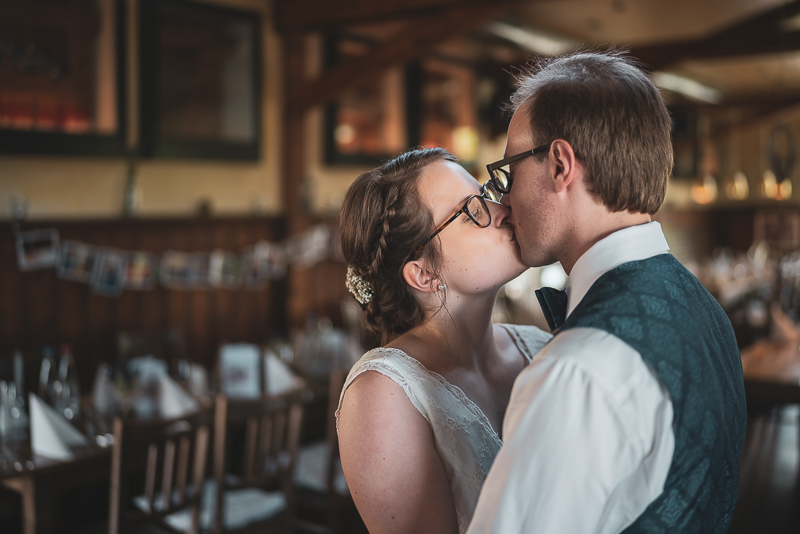
When shooting a wedding you will probably care most about bokeh, good sharpness across most of the frame from wide open, speed and AF which should be fast and reliable. Price may or may not be an important aspect. Requirements for shooting family are similar with a bigger emphasis on AF-speed for smaller children.
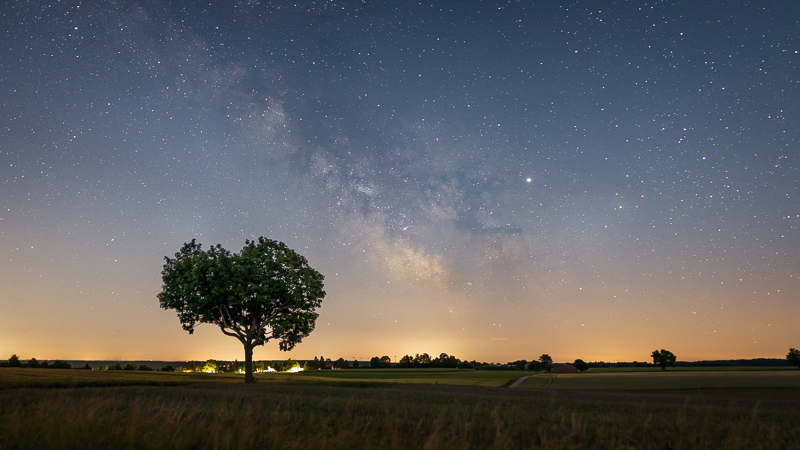
For astro-photography you want a fast lens with good coma correction and as little vignetting as possible. Many people also prefer manual lenses here.
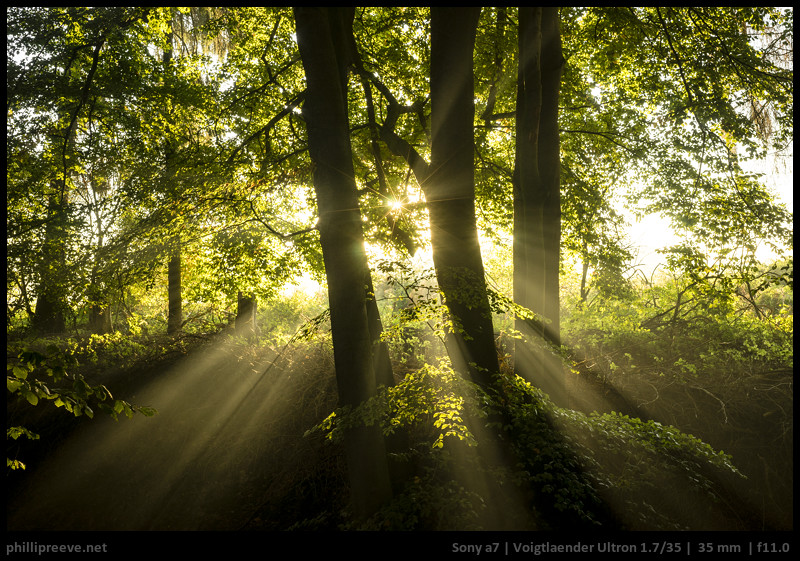
When photographing a landscape or architecture you will probably care about good sharpness at f/8 or f/11, high contrast, good flare resistance, manual focus experience and maybe nice sunstars or small weight.
2. What is your budget?
You can spend anywhere from $150 to $1500 for a 35mm E-mount lens. You can also adapt a good legacy 35mm for a little over $50. As a rule of thumb more money gets you better optical quality, better build quality, better reliability and faster lenses. There are some rather embarrassing exceptions to this rule of thumb in the E-mount 35mm lineup though.
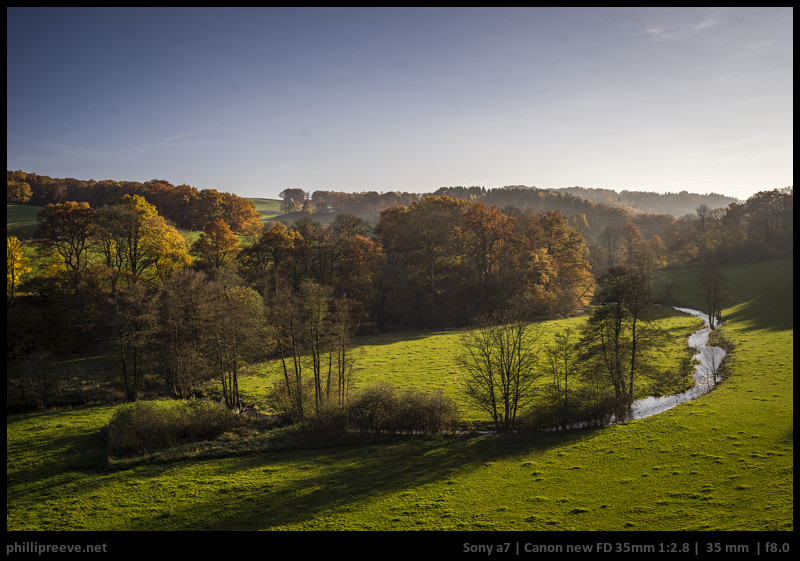
How much should you spend? If you are on a very tight budget but a competent photographer you will get very good results out of a $50 lens but you will have to deal with a few scenarios where you would have gotten better results with a more expensive lens. But keep in mind we all know that guy who reliably gets bad results out of his $4000 Leica lens. Since available income differs so much it is impossible to give a general recommendation here but it is a good idea to consider how much you will use a lens, how much joy you will get out of using it and count that against much how much you will miss the money it cost you.
When considering the price of a lens also look at the long term cost of it. A cheap $350 lens which breaks after 1 year of use costs you $350 for a year of use. A more expensive $600 lens you bought used that can be sold after a year for $550 costs you $50 for a year of use. And it was probably more enjoyable to use in that year. There is also an effect called “early adopter tax”: the value of newly released lenses usually depreciates rather quickly in the first year.
3. Size & Weight
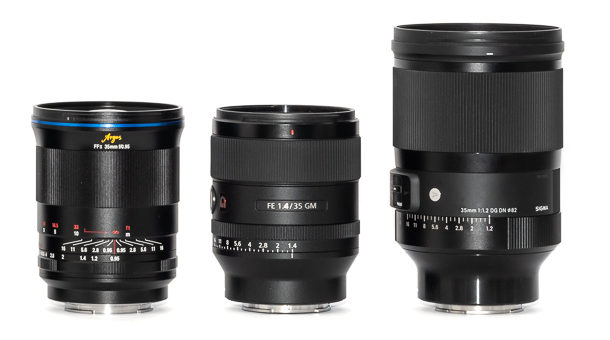
The lightest 35mm E-mount lens ist the Samyang 2.8/35 at 86g, while the heaviest lens, the Sigma 1.2/35, weighs 1090g. The three most important factors for the weight of a lens are speed, vignetting and the degree of optical correction. The Sigma 1.2/35 is not only 2.5 stops faster than the Samyang: its optical design is also a lot more complex which results in much higher sharpness and better correction of aberrations. The Sigma also has a lot less vignetting.
Again needs are very different: If you do a lot of hiking you probably don’t want to carry the very heavy Sigma, but a slower, lighter lens. As a wedding photographer on the other hand performance will usually be more important than weight. Lenses also need to fit into your camera bag.
4. How fast does it need to be?
A faster f/1.4 lens allows you to blur your background more than a slower f/2.8 lens and it also lets in more light, allowing for lower ISO or shorter shutter speeds. Faster lenses are usually bigger, heavier and more expensive than slower lenses but there are exceptions to both rules we mention in the discussion of each lens.
So how fast does your lens need to be? If you chose a f/1.8 lens over a f/1.4 lens this will seldom make the difference between a good and a bad picture but it often is one important factor for the look of your images. Also keep in mind that the quality of the blur (bokeh) can be more important than the amount of blur.
5. Do you prefer AF or manual focus?
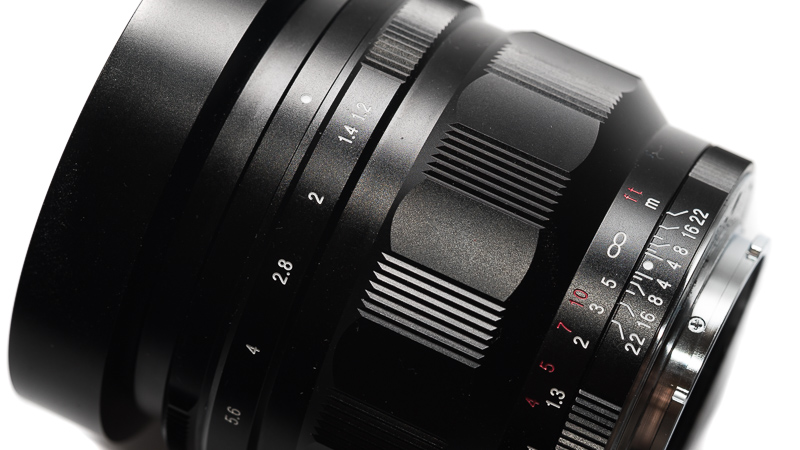
Most users will answer that they want an AF-lens. In that case one needs to consider how fast and how reliable AF needs to be.
Some users prefer to focus manually because it makes photography more enjoyable to them. Even some native lenses are manual focus only and they are a joy to use since they have a proper focus helicoid and a smooth focusing ring. Almost all AF E-mount lenses are less pleasant to focus manually because they are focus-by-wire designs where there is a small but noticeable lag between the moment you turn the focus-ring and the actual change of focus and, secondly, the focus ring offers the wrong amount of resistance or even has some play. Many also have variable (non-linear) throw, meaning that the amount the focus changes when you turn the focussing right depends not just on how far you turn the focussing ring, but on how fast you turn it. In theory this helps you make big changes quickly, and then focus slowly for fine-tuning. In practice many experienced manual-lens-users find it hard to adjust to and very unpredictable.
Native 35mm Lenses with AF
Sigma 35mm 1.2 Art DG DN
Recommended
- Amazing sharpness and contrast already at f/1.2 and no field
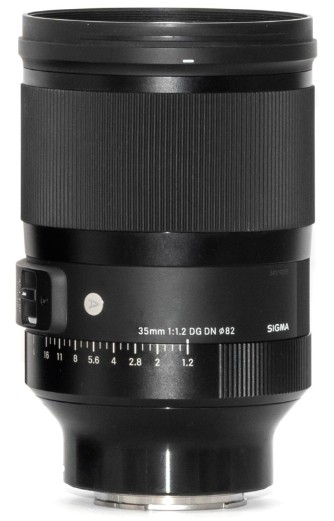 curvature at infinity (resolution everywhere in the frame is as good at f/1.2 as it is at f/11!)
curvature at infinity (resolution everywhere in the frame is as good at f/1.2 as it is at f/11!) - Soft bokeh with smooth transitions, for many the best among all 35mm lenses
- Good to very good coma correction but average vignetting figures (good idea to slightly stop down for astrophotography to get a more even exposure)
- Above average correction of purple fringing
- GM handling with aperture ring, AF/MF switch and additional lens button
- Above average linear distortion which is easily corrected in post
- Big, heavy, expensive
The first actually good fast 35mm lens for the E-mount when it had been released in 2019. Smoothest bokeh in a 35mm lens we have seen yet and together with the Sony FE 50mm 1.2 GM the best performing f/1.2 lens in terms of optical qualities you can put on your E-mount camera.
If you are looking for something with these properties you will forget the weight when you see the resulting images.
This lens has been discontinued and Sigma announced in early 2025 that they are working on a Mk II version which is smaller and lighter. No release date was given.
1090g | $1399 | Review | aperture series | sample images
buy from amazon.com | B&H | ebay.com | ebay.de (affiliate links)

Sony FE 35mm 1.4 GM
Recommended
- Surprisingly small and lightweight
- Amazing sharpness and contrast already at f/1.4 and no noticeable field curvature at infinity
- Good bokeh
- Good to very good coma correction but average vignetting figures
- Above average correction of purple fringing
- GM handling with aperture ring, AF/MF switch and additional lens button
- expensive
One of Sony’s most impressive lenses so far. A 35mm 1.4 as small as the already small 24mm 1.4 GM – something no one here thought would be feasible. Better sharpness than anyone would ever need, good bokeh rendering.
520g | $1298 | Review
buy from amazon.com | amazon.de | B&H | ebay.com | ebay.de (affiliate links)
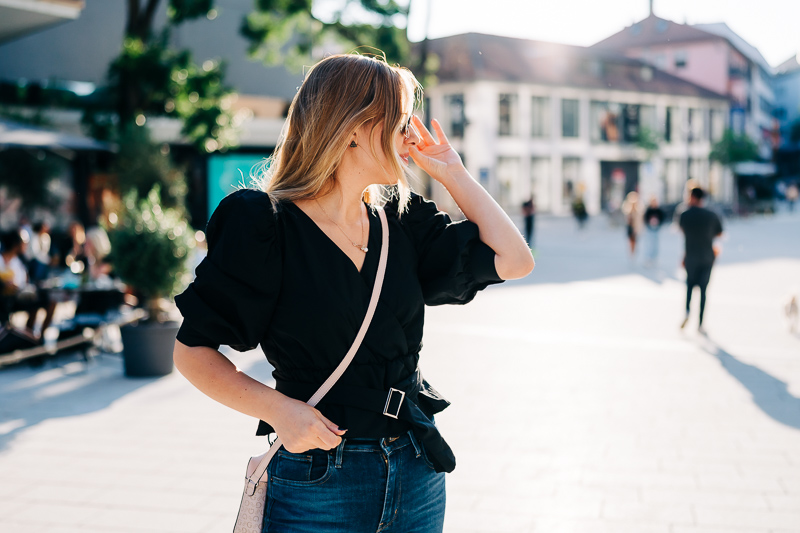
Sony/Zeiss FE 35mm 1.4 ZA
- Smooth bokeh in combination with decent contrast at maximum
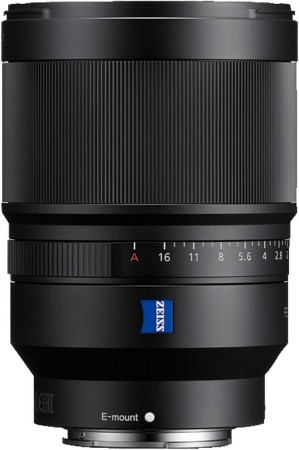 aperture leads to appealing images in many scenarios
aperture leads to appealing images in many scenarios - Field curvature makes it a not so great performer for infinity shooting, especially at wider apertures
- Shows onion ring structures in out of focus highlights
- High amount of purple fringing
- Good coma correction and average vignetting figures
- Very high sample variation
- Above average and wavy barrel distortion
- Compared to the GM lenses no lens button and non linear manual focus by wire
- Expensive
We know some of you bought one while all the planets in our solar system were perfectly aligned and therefore got a great copy, but in most cases one corner is significantly less sharp than the others, or the entire field is tilted so one side is noticeably less sharp than the other. For anyone in the market for a fast 35mm lens now – considering the alternatives – we cannot recommend this one, especially for MSRP.
This lens has been rendered useless by the Sony FE 35mm 1.4 GM.
630g | $998 | Review | aperture series | sample images
buy from amazon.com | amazon.de | B&H | ebay.com | ebay.de (affiliate links)
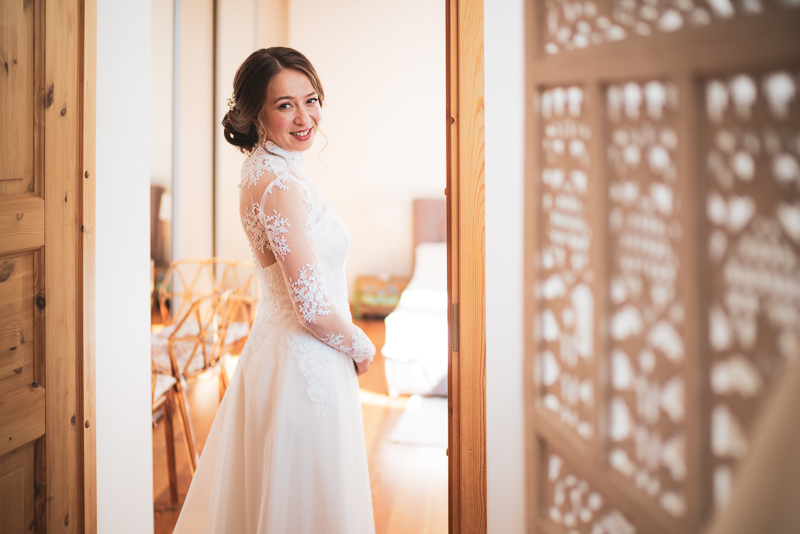
Sigma 35mm 1.4 Art DG DN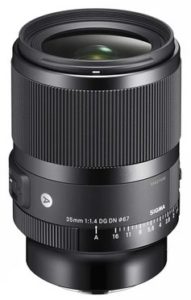
Sigma updated its classic 35mm 1.4 Art lens with better optics leading to better sharpness and nicer bokeh while making it smaller and lighter.
The only thing we could complain about: it is not as high resolving as the Sony FE 35mm 1.4 GM and also slightly heavier and bigger.
645g | $799 | Cameralabs Review
buy from amazon.com | amazon.de | B&H | ebay.com | ebay.de (affiliate links)
Sigma 35mm 1.4 Art DG HSM (former DSLR design)
- Good sharpness and contrast but also a bit of field curvature, so
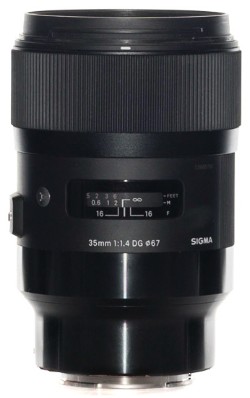 best used at f/5.6 to f/8.0 for infinity shooting
best used at f/5.6 to f/8.0 for infinity shooting - Bokeh is good but not excellent as at longer focus distances double edged structures can become noticeable
- Shows onion ring structures in out of focus highlights
- Purple fringing can be visible in harsh light
- Coma correction is decent and the lens is certainly usable for astrophotography
- AF/MF-switch, direct mechanical coupling between focus ring and focus group (the only AF lens listed here without focus-by-wire)
- The heaviest native 35mm f/1.4 lens with AF (95g more than the Samyang)
This was Sigma’s first Art lens and they got a lot right: nice build quality, good optics, decently priced. A versatile lens without any major downsides, something we only rarely see.
Still, the aforementioned true mirrorless Sigma 35mm 1.4 Art DG DN is the much smarter choice these days.
740g | $899 | Review | aperture series | sample images | Comparison to Sigma 35mm 1.2 Art DG DN
buy from amazon.com | amazon.de | B&H | ebay.com | ebay.de (affiliate links)
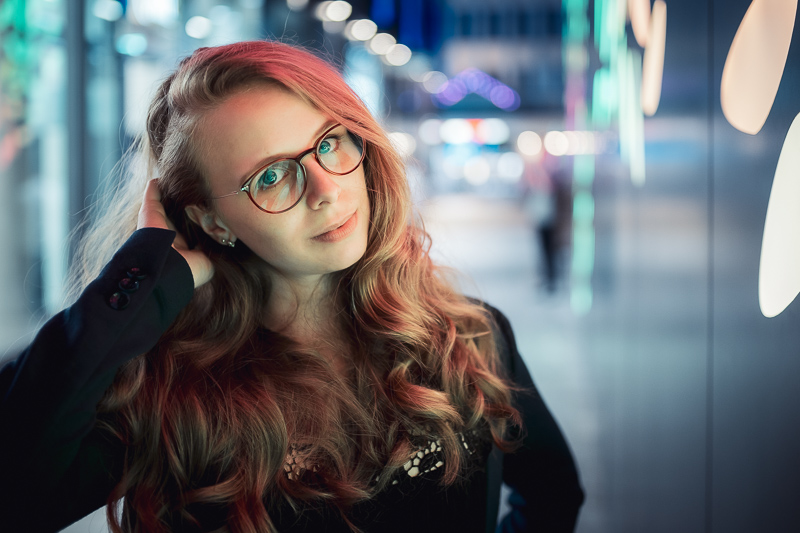
Samyang 35mm 1.4 AF (MK II)
- Good to very good sharpness from wide open across the frame,
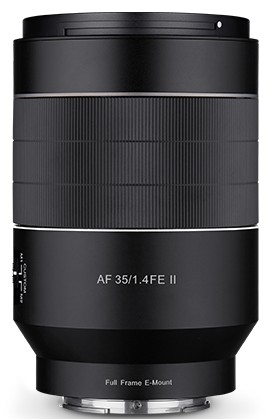 very stopped down with some field curvature.
very stopped down with some field curvature. - Smooth bokeh most of the time. A little nervous off-center at longer distances.
- Rather strong CA, average vignetting and flare resistance.
- Above average astro-performance, usable from wide open.
- Manual focus is annoying because the default setting (can be changed with optional dock) has a too steep transmission and jumps from one distance to another with too few intermediate steps.
- No focus button and no AF/MF-Switch on MK I, both have been introduced in MK II
- Froze Phillip’s a7II several time when he tried shooting a wedding with it (MK I)
- There are quite a few reports of lenses stopping to work after a few months of work (MK I)
It is surprising how good the Samyang is optically if you consider its price. For below $449 it holds its own against many more expensive 35mm lenses.
This lens has been updated to an MK II version with unchanged optics but improved mechanical design and electronics. We haven’t used the updated version personally, but we hope it solved some of the issues we had with the original one.
645g | $449 (MKI) and $699 (MKII) | review
buy from amazon.com | buy from eBay | B&H (affiliate links)

Sony FE 35mm 1.8
- Good to very good sharpness from wide open across the frame,
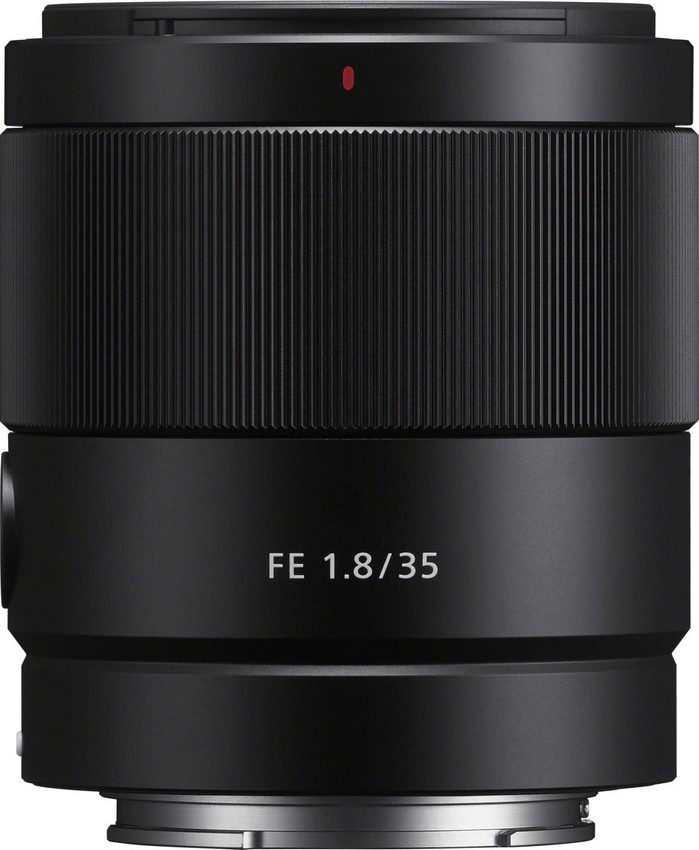 excellent stopped down.
excellent stopped down. - Smooth bokeh most of the time. Nervous off-center at longer distances.
- Rather strong CA, average vignetting and flare resistance.
- AF/MF-Switch and Focus-hold button.
- Very fast and reliable AF.
- Decent manual focus for an AF-lens.
- Small and light.
- Expensive
While the Sony FE 1.8/35 doesn’t excel in any category it performs well in most of them and has no serious flaws. It is much more portable than the f/1.4 lenses and optically superior to the slower f/2.8 lenses.
Unless very fast AF is important it might be worth checking out the Sigma 2/35 as well though.
280g | $748 | Review
buy from Amazon.com | B&H | ebay.com | Amazon.de (affiliate links)
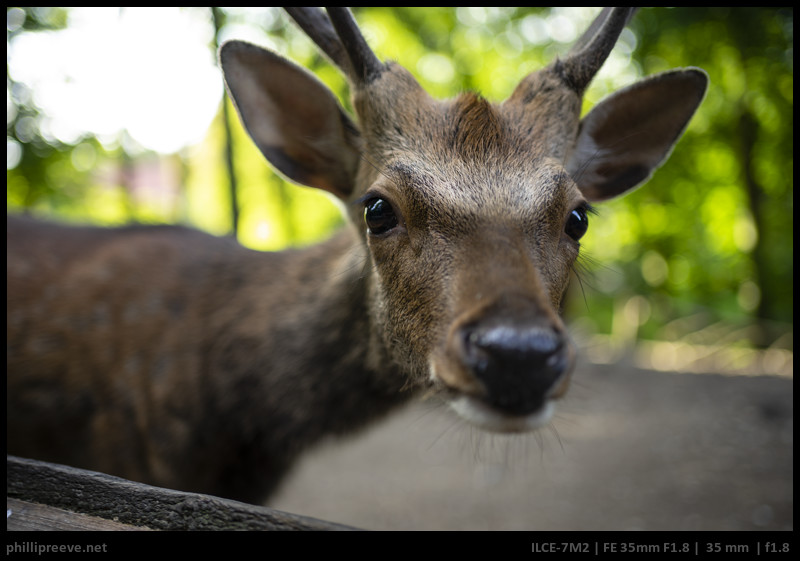
Samyang 35mm 1.8 AF
The Samyang 35mm 1.8 AF is a decent low cost alternative to the  slightly overpriced Sony 35mm 1.8 lens. Ultimately you get what you pay for though, as longitudinal CA are a bit on the high side as is distortion and you get to deal with onion ring structures in out of focus highlights.
slightly overpriced Sony 35mm 1.8 lens. Ultimately you get what you pay for though, as longitudinal CA are a bit on the high side as is distortion and you get to deal with onion ring structures in out of focus highlights.
210g | $399 | Lenstip Review
buy from amazon.com | amazon.de | ebay.com | ebay.de | B&H (affiliate links)
Sigma 35mm F2 DG DN
Recommended
- Good to very good sharpness from wide open across the frame,
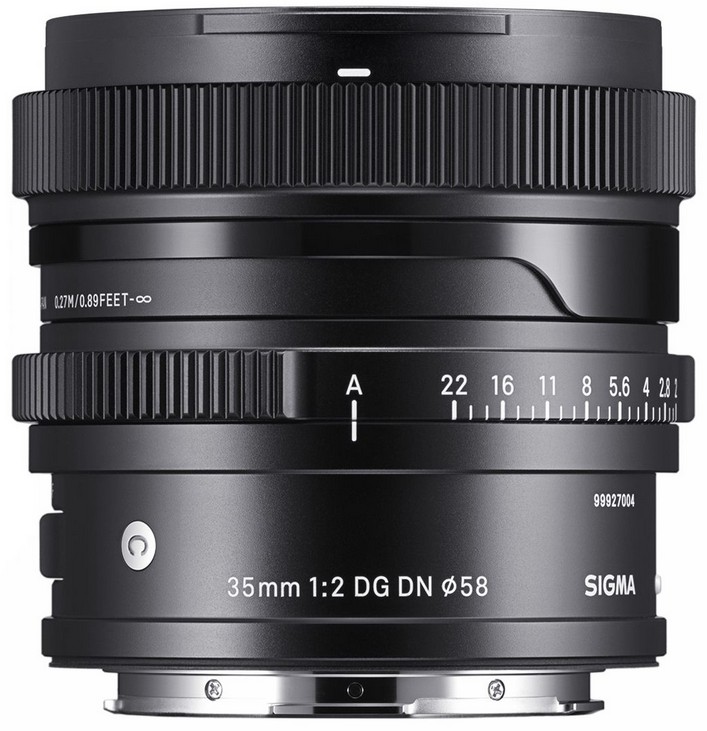 excellent stopped down.
excellent stopped down. - Smooth bokeh even in more challenging scenarios where most other 35mm lenses fail.
- Good but not perfect CA correction.
- Average vignetting and flare resistance.
- AF/MF-Switch and Aperture ring.
- Fast and reliable AF
- Good manual focus for an AF-lens.
- Feels very solid thanks to milled metal outer case.
- A bit heavier than the Sony/Samyang 1.8/35 but still small and light.
While all 35mm lenses that came before the Sigma came with a number of optical compromises, the 2/35 doesn’t. It delivers a very convincing performance in any area with smooth rendering – even in more challenging scenarios. It also feels a lot nicer in your hand. And it does all that for less than Sony’s own 1.8/35. So the Sigma 2/35 is an easy recommendation.
325g | Price: $589
buy from Amazon.com | B&H | ebay.com | Amazon.de (affiliate links)
Sony ZA 35mm 2.8 FE
- Quite high resolution at open aperture
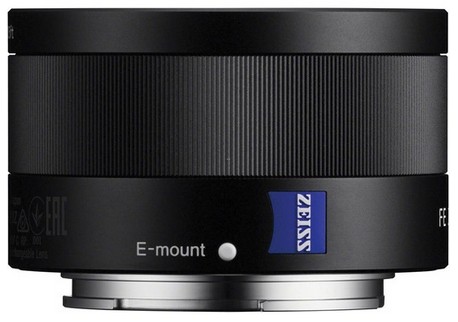
- Good contrast
- Does not improve much with stopping down
- Undefined sunstars
- A bit more glare and contrast drop in backlight than ideal for a modern lens
- Good AF
- Fairly high variation as with many early FE lenses. Buy from a source when you can test or return.
- Nothing exciting about the bokeh in either quality or quantity
This is a very small and light and decently sharp lens that is very attractive for someone who wants a lightweight 35 for hiking or similar purposes. Looks pretty outdated next to Sony’s newer G primes (24mm 2.8G, 40mm 2.5G and 50mm 2.5G).
120g | $598 | Review
buy from amazon.com | B&H | ebay.com (affiliate links)
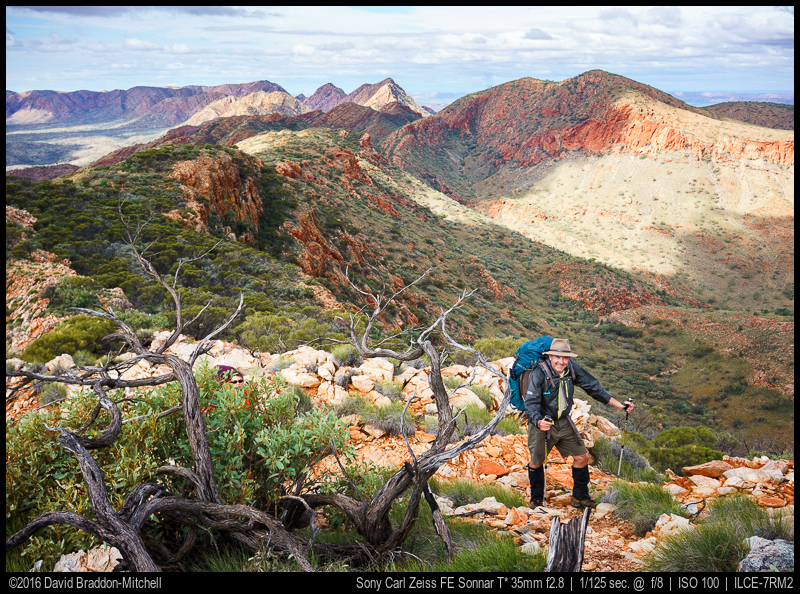
Samyang 35mm 2.8 AF
- Decently sharp: sharper than most legacy 35s

- Decent flare control
- Good CA correction.
- Wonderfully small and light, and inexpensive
- OK AF but not as good as the Sony Zeiss
- Slightly cheap feeling build and hood
- We encountered sample variation issues
If you can find a good copy this is very inexpensive and optically decent, and perhaps a good lens to take on expeditions where every gram counts.
95g | $220
buy from amazon.com | B&H | ebay.com (affiliate links)

Tamron 35mm 2.8 Di III OSD M1:2
- Very good sharpness at infinity
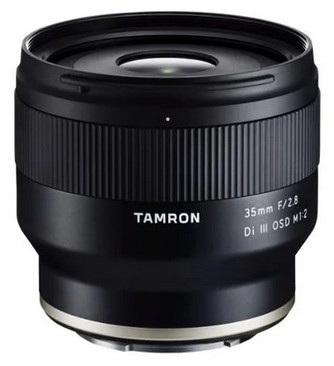
- Good flare resistance
- High vignetting
- Very lightweight but not very small
- Maximum magnification of 1:2
- Slow autofocus and bad manual focus experience
The 35mm 2.8 is probably the best ouf of Tamron’s wide f/2.8 primes, but there are so many (faster) 35mm options available these days, it becomes somewhat hard to recommend unlike you really don’t need a lens faster than f/2.8.
210g | $299 | Review | aperture series
buy from amazon.com | amazon.de | B&H | ebay.com (affiliate links)
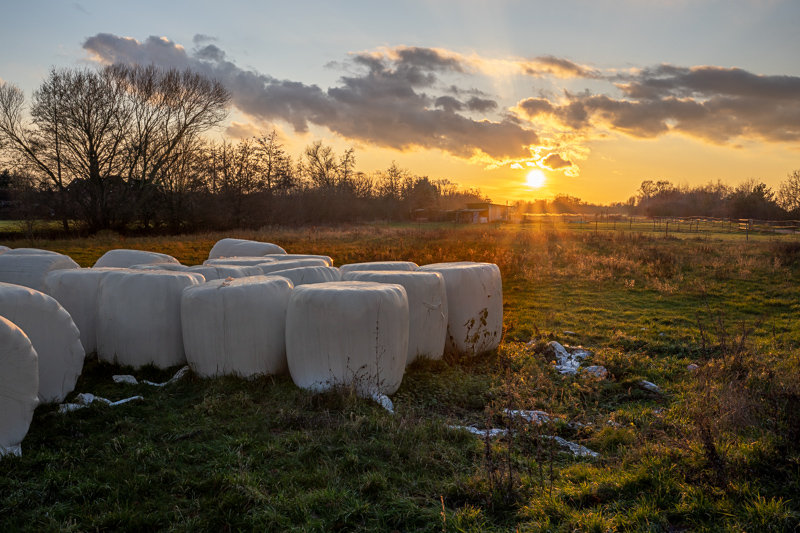
Native 35mm Lenses without AF
Laowa 35mm 0.95 Argus
Recommended
- Unique specifications
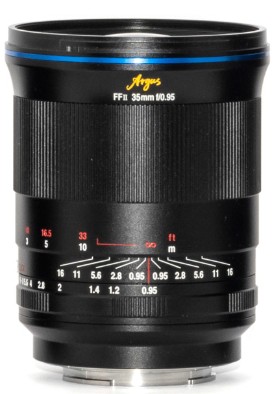
- Amazing bokeh rendering
- Sharp where it matters
- Above average vignetting figures, especially stopped down
- Average flare resistance
- Surprisingly good coma correction for an f/0.95 lens
- Good build quality
- Compact for what it is and reasonably priced
- No electronic contacts / Exif data
The world’s fastest 35mm fullframe lens and also the world’s widest f/0.95 lens for fullframe. Compared to other affordable f/0.95 lenses the optics are surprisingly good, compared to the only other high quality f/0.95 lens (the Nikon 58mm 0.95) this Laowa lens is surprisingly compact and cheap.
Great choice for environmental portraiture when AF is not needed and tied for the lead with Sigma 35mm 1.2 for being the 35mm lens with the most appealing bokeh rendering.
795g | $649 | Review | aperture series | sample images
buy from manufacturer’s homepage | ebay.com | B&H (affiliate links)
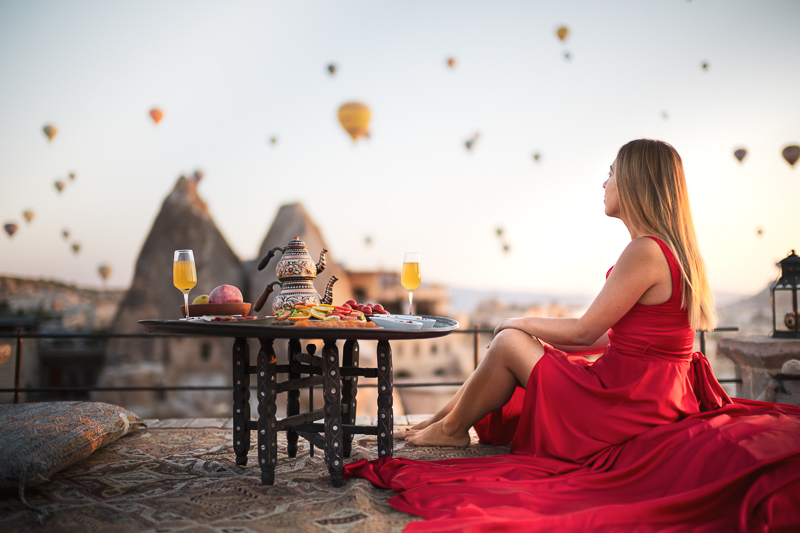
Voigtlander 35mm 1.2 Nokton E
Recommended
- Very smooth bokeh most of the time
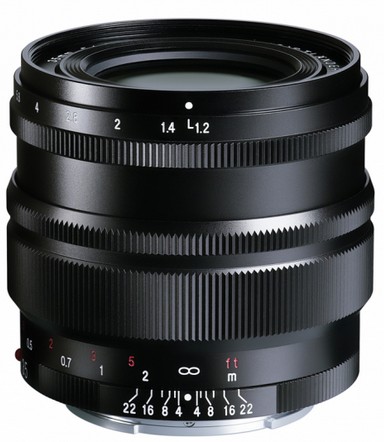
- Sharp enough from wide open, optimized for portrait distance, stopped down the corners never reach excellent values, also thanks to some field curvature
- Bad coma correction, not a good choice for astrophotography
- Good flare resistance
- High vignetting
- Excellent handling and build quality
- Nice sunstars
- Great size/performance ration
If you are into manual focus this is a very compelling 35mm option. Nice bokeh, good contrast, good flare resistance, stopped down good enough sharpness and nice sunstars.
Discontinued
387g | $699 | Review | aperture series | sample images
buy from amazon.com | amazon.de | B&H | ebay.com (affiliate links)
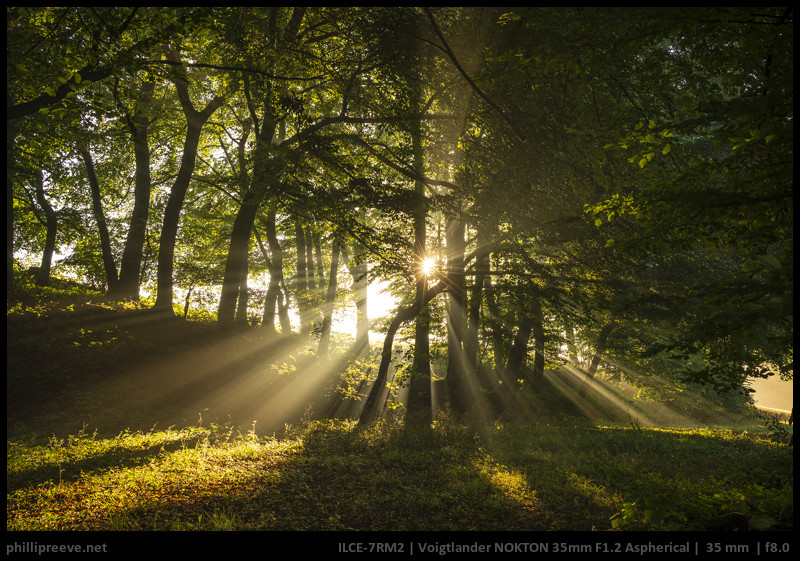
SLRmagic 35mm 1.2 Cine
- Lots of background blur for the money
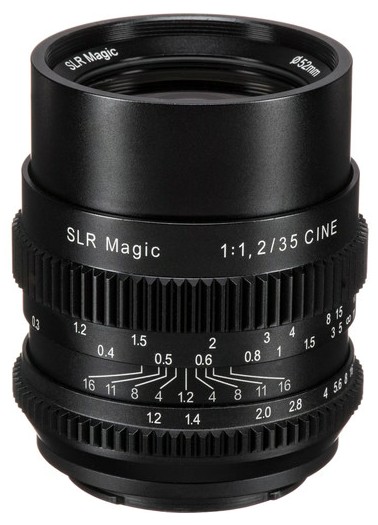
- Very “classic” bokeh rendering with lots of outlining at maximum aperture, which gets smoother as you stop down
- Optimized for portrait distance, so at f/1.2 decent sharpness only at this distance and lots of glow at infinity, corners at infinity never look really good
- Bad coma correction, not a good choice for astrophotography
- Bad flare resistance
- Above average vignetting figures
- Noticeable focus shift
- Fuzzy sunstars
- Cine lens with gears therefore not very pleasant to use for photography
- No electronic contacts / Exif data
If you are looking for a fast 35mm lens that gives a “classic look” – meaning busy bokeh, mediocre sharpness and contrast and lots of optical aberrations – it is probably a better idea to go for the 7Artisans 35mm 1.4, which will only set you back $199 and is more enjoyable to use. The Pergear 35mm 1.4 features a more “modern performance” making it an even better deal, so I see little reason to still consider this SLRmagic lens.
466g | $399 | Review | aperture series | sample images
buy from amazon.com | B&H | ebay.com | ebay.de (affiliate links)
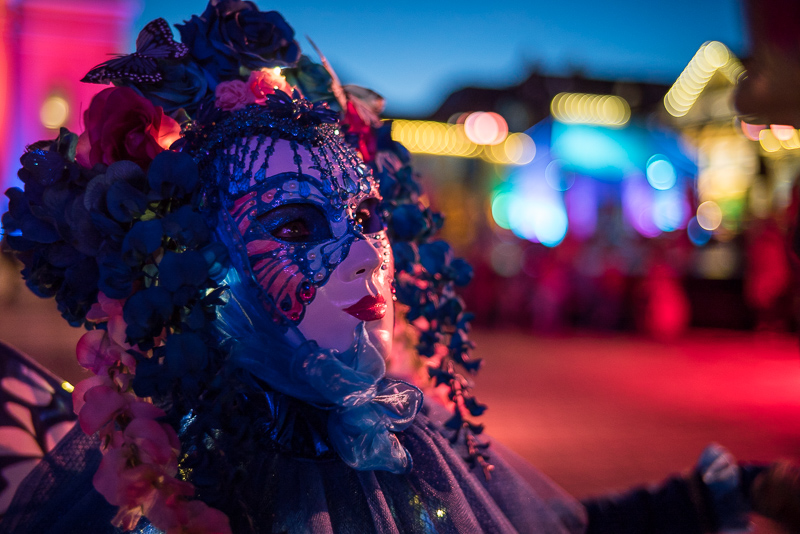
Voigtlander 35mm 1.4 Nokton E Classic
- Very “classic” (busy) bokeh rendering with lots of outlining from
 f/1.4 to f/2.0, this gets smoother as you stop down to f/2.8 or further
f/1.4 to f/2.0, this gets smoother as you stop down to f/2.8 or further - Needs to be stopped down to f/8 to f/11 for decent infinity performance and corners still not looking great
- Bad coma correction, not a good choice for astrophotography
- Good flare resistance stopped down, bad flare resistance at f/1.4 to f/1.7
- High vignetting figures
- Above average distortion
- Noticeable focus shift
- Well defined 10-stroke sunstars stopped down
- Great handling and build quality
I am not a big fan of this lens. At maximum aperture the optical qualities are similar to those of the 7Artisans 35mm 1.4 or SLRmagic 35mm 1.2 Cine, yet it is much more expensive. It is a better performer stopped down though and compared to the aforementioned lenses you get electronic contacts providing Exif data. I would rather recommend getting a used Sigma 35mm 1.4 Art and a new 7Artisans 35mm 1.4 instead for the same money. That way you will have a versatile and useful general purpose 35mm 1.4 lens and a cheap funky one – instead of only an expensive funky one.
262g | $599 | Review | aperture series | sample images
buy from CameraQuest | B&H | amazon.com | amazon.de | ebay.com | ebay.de (affiliate links)
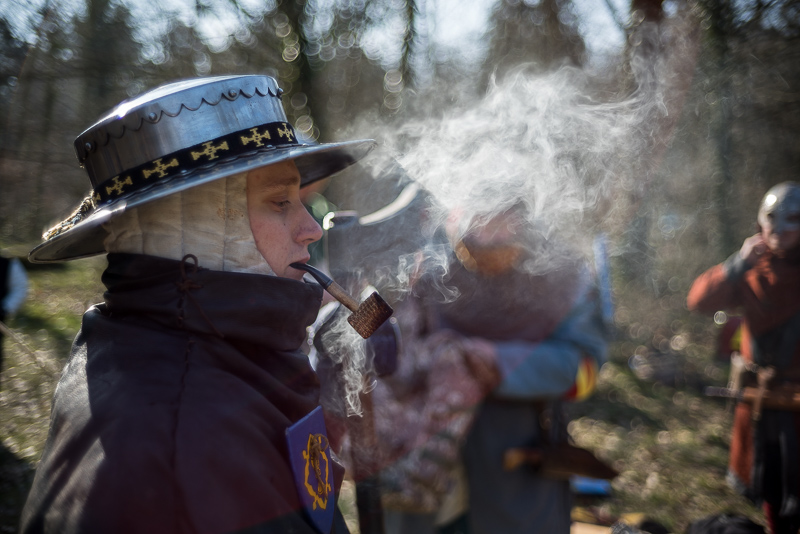
Pergear 35mm 1.4
- Cheapest fast fullframe 35mm lens for E-mount
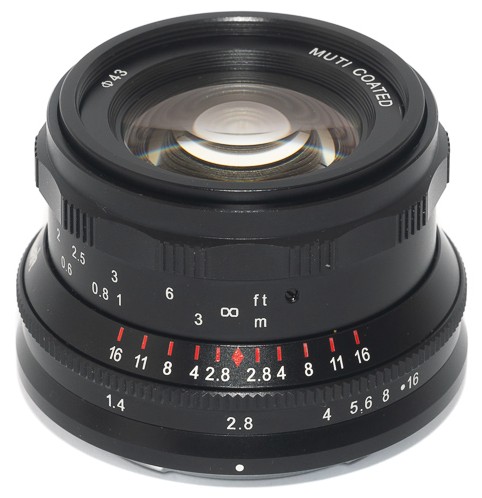
- Nice bokeh at most distances, especially compared to other cheap 35mm lenses like the TTArtisan 35mm 1.4 or SLRmagic 35mm 1.2 and also some more expensive ones like Zeiss Loxia 35mm 2.0 or Voigtländer 35mm 1.4 Classic
- Sharpness only average and also comes with some field curvature issues, therefore needs to be stopped down to f/8 to f/11 for decent infinity performance
- Average flare resistance, vignetting figures and coma correction
- High distortion, luckily easy to correct in post
- Full metal construction and nice handling
- No electronic contacts / Exif data
A lot of lens for the money. This can be a great option if you don’t have a fast prime yet. If you are mainly using a midrange or superzoom like the Sony 24-105mm 4.0 or Tamron 28-200 or even one of the 28-70mm 2.8 lenses, this Pergear can greatly expand the capabilities of your kit without weighing you down or breaking the bank.
237g | $129 | Full Review
buy from amazon.com | amazon.de | ebay.com | ebay.de (affiliate links)
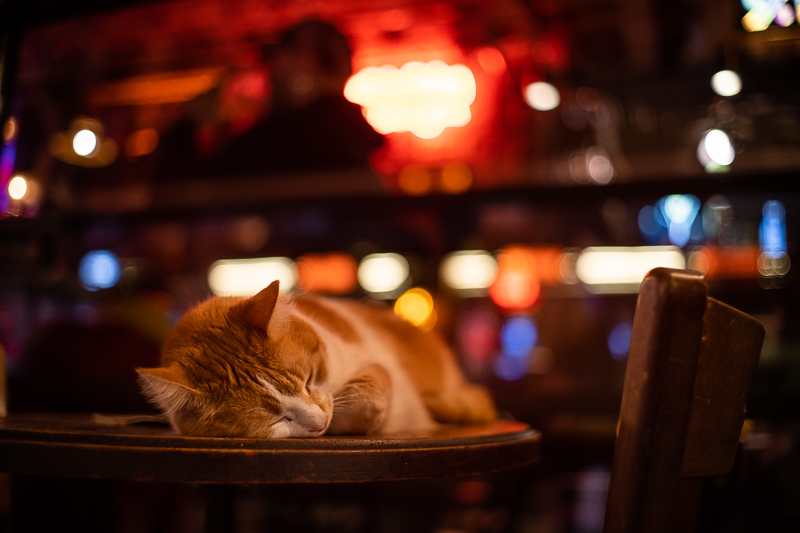
7Artisans 35mm 1.4
- Soft at f/1.4, sharpens up to ok levels at f/2 and never gets very
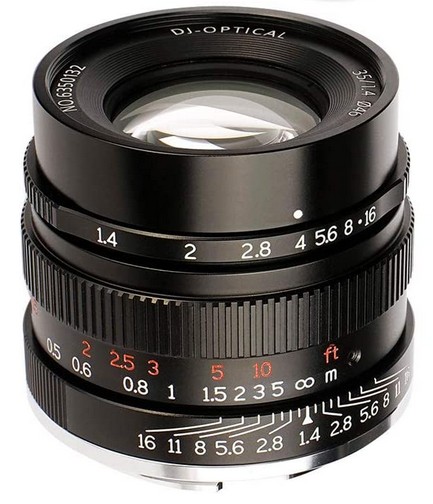 sharp across the frame in part because of the strong field curvature.
sharp across the frame in part because of the strong field curvature. - Very nervous bokeh wide open, smoother at f/2 and smooth by f/2.8.
- Strong CA, flares and vignetting.
- Fuzzy sunstars.
- Very small and relatively light.
- Very good build quality and excellent handling.
- Very affordable
- No electronic contacts / Exif data
A special effect lens with funky rendering at f/1.4, smoother rendering stopped down and lots of aberrations. It is pleasant to handle and affordable. Might be worth checking out if you are after different rendering but we can’t recommended it as a general purpose lens.
300g | $199 | Review
buy from Amazon.com | Ebay.com | B&H (affiliate links)
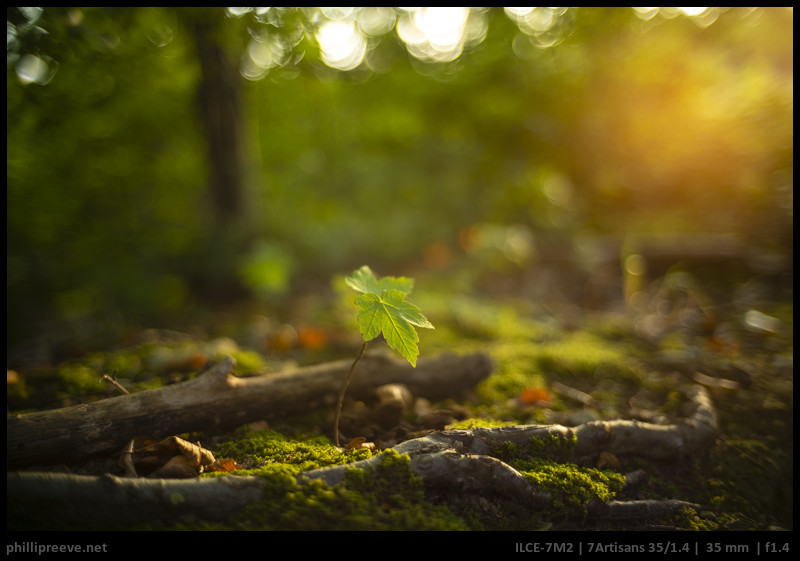
Voigtländer 35mm 2.0 E Apo-Lanthar
Recommended
- Very good correction of most of the optical aberrations and
 therefore high image quality across the frame even at f/2.0
therefore high image quality across the frame even at f/2.0 - Less distracting bokeh than the Zeiss Loxia 35mm 2.0, but not as appealing as that of some of the other lenses on this list
- Low distortion
- Average flare resistance
- Very good coma correction but also very high vignetting even stopped down, therefore not the ideal choice for astrophotography
- Interesting aperture construction that is perfectly round at some apertures and yields well defined sunstars at others
- Nice build quality
If you mainly use your 35mm lens for architecture or landscape shooting this is the one you are looking for. It offers very high contrast as well as resolution coupled with a good correction of almost all optical aberrations. It is in many ways the better Zeiss Loxia 35mm 2.0, but if you already have the Zeiss lens and you are thinking of upgrading: this only makes sense when you want to use the lens at wider apertures often.
353g | $949 | Review | sample images
buy from Robert White (UK) | Cameraquest (US) | B&H | ebay.com | ebay.de (affiliate links)
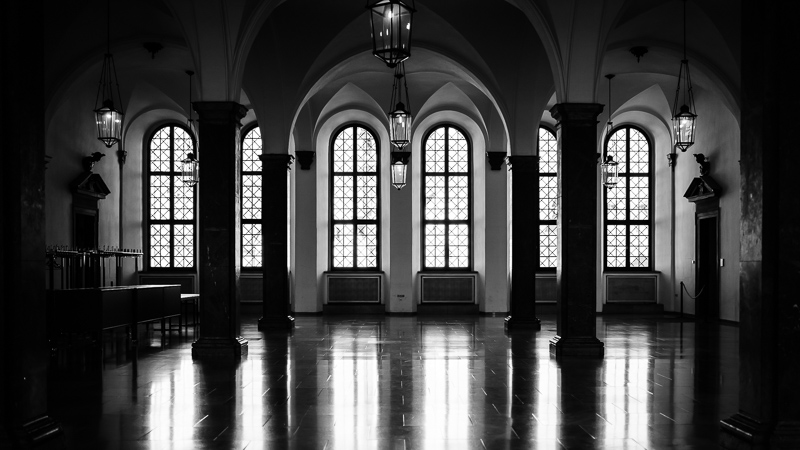
Zeiss 35mm 2.0 Loxia
- Exceptional performer stopped down to f/8 to f/11 for landscape/
 architecture due to high contrast and resolution
architecture due to high contrast and resolution - Soft corners (mostly due to field curvature) at wider apertures
- “Classic” (busy) bokeh rendering with lots of outlining at f/2.0, this gets smoother as you stop down
- Low distortion
- Average vignetting figures
- Average flare resistance
- Bad coma performance at f/2.0 to f/2.8, not a good choice for astrophotography
- Well defined 10-stroke sunstars stopped down
- Nice build quality (PocketPANO Lens-Grip recommended)
- Expensive, too expensive new, look for a used one
If you are looking at this one because you are a happy with the Loxia 21mm, 25mm or 85mm you may be disappointed: this one is not playing in the same league.
It is a rather old rangefinder design “tweaked” for the E-mount cameras. It is a very good performer stopped down to f/8 to f/11 though with very high contrast, nice resolution and beautiful sunstars, but the bokeh at maximum aperture is rather busy and often distracting.
The aforementioned Voigtländer 35mm 2.0 Apo-Lanthar E beats it at its own game.
340g | $1349 | Review | aperture series | sample images
buy from Amazon.com | Amazon.de | B&H (affiliate links)
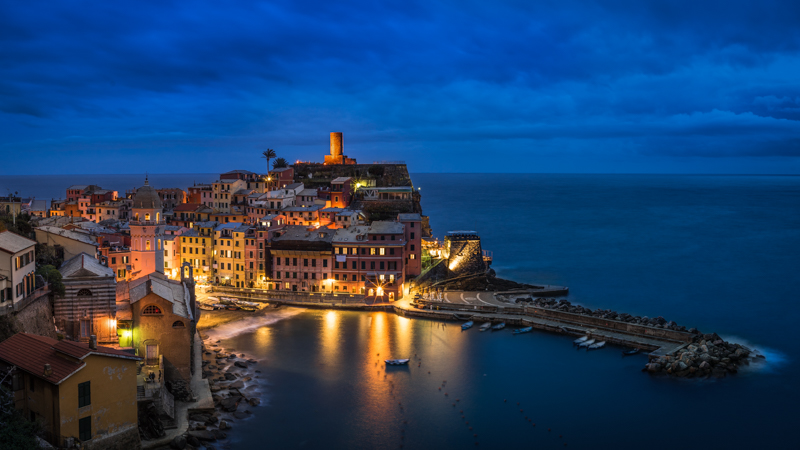
Closing Remarks
We hope that this guide can help you in your purchase decision. If any questions are left unanswered don’t hesitate to leave a comment.
Articles like this require many hours of work. If you found it helpful, you can support us by:
- Using one of our affiliate links if you buy a lens (or anything else, diapers for example), won’t cost you anything extra but helps us a lot.
- If you own an interesting and/or exotic lens and you would be willing to part with it for a few weeks for us to write a review just leave a note.
- It also helps a lot if you share this article on social media and with your friends.
Thanks!
Other Articles
- All our Guides
- All our Lens Reviews
- Lens aberrations explained
- Bokeh explained
- How to: Create environmental portraits
Support Us
Did you find this article useful or just liked reading it? Treat us to a coffee!
![]()
![]()
![]() via Paypal
via Paypal
This site contains affiliate links. If you make a purchase using any of the links marked as affiliate links, I may receive a small commission at no additional cost to you. This helps support the creation of future content.
The Team
Latest posts by The Team (see all)
- November / Black Friday Deals 2025 - November 19, 2025
- Sony FE Lenses: The honest Guide for the A7/A9/A1 Series - March 18, 2025
- Guide to best Sony E-Mount 35mm Lenses for A7/A9/A1 series - March 8, 2025
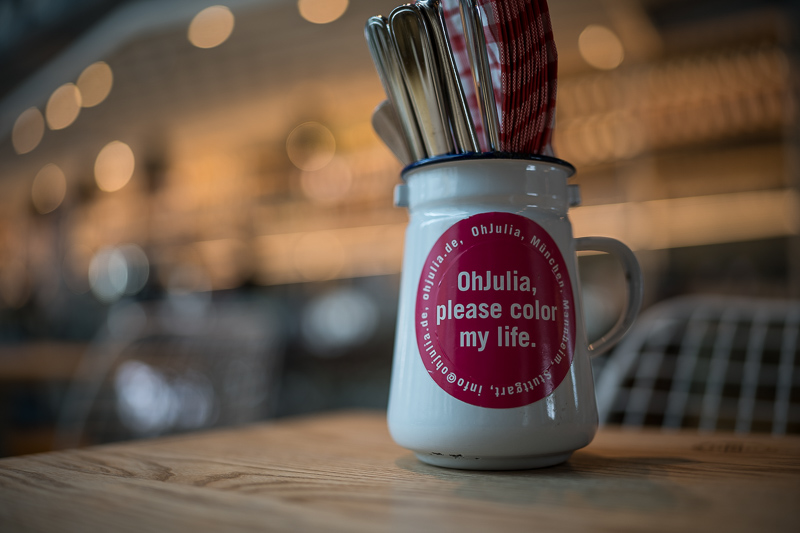
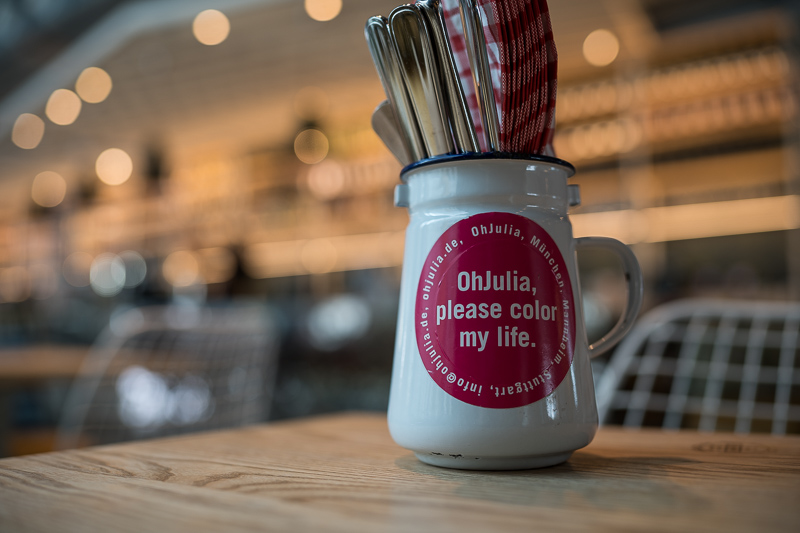
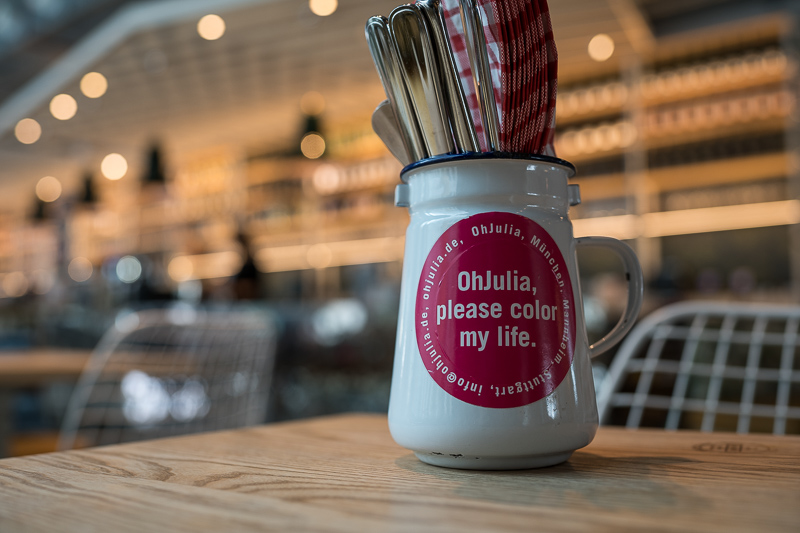
I wonder why Cosina haven’t made E-mount version of their 35mm F1.7 with electronic contacts. Lack of F1.7-F2 lenses on E-mount could make it popular, even compared to M version, which has several competitors like Summircron or ZM.
So far we have only seen 1 out of 6 lenses from the “Vintage” line being ported to E-mount.
I guess we might get a 35mm 2.0 APO Lanthar at some point.
I totally forgot about Loxia 35 F2. Since FE 35 F1.8 beats the Loxia in resolution, Cosina might make APO-Lanthar.
A 2.0/35 APO Lanthar would indeed be welcome. However, since I’ve been using a ZM 1.4/35 almost exclusively for the past six months, I’d be delighted if Zeiss could port that design to a Loxia format to match the Sony filter stack. That would be something.
I can see how that would appeal. Personally my preference is for a more compact manual 35 than that lens could be, and refer an AF lens for super fast use, but of course we all have different needs.
The 35mm f/2 Summicron-M IV might be quite close to what you want–except in price. That pre-ASPH version seems to work well with the Sony filter stack.
Do you have any actual proof that it does?
Because, honestly, I don’t believe it.
Hi, Bastian–
No, I have no proof that the lens that I mentioned works well on the Sony bodies. I relied on the repeated posts in the dpreview Sony and Adapted Lenses forums by “Rol Lei Nut,” who has for years demonstrated an interest in a wide variety of lenses with an emphasis on a lightweight kit. Over recent years he’s posted information like this:
https://www.dpreview.com/forums/post/62962777
I’ve been interested in the little Summicron that he’s mentioned repeatedly, but since I already have a 35mm that suits me (except for its weight) I’ve not been interested enough to buy one. If you were to test one and find it good, though. . . .
As people say: a picture is worth more than a thousand words and I haven’t yet seen one to back that claim 🙂
Thank you for this Bastian. What would you recommend as the best 35 for concert photography…wide open apertures, fast AF, good and not too sensitive MF adjustments when the subjects are more still? I’ve been shooting 50 and 85 primes to date and shoot a lot of shows, but need a 35 prime to add to the bag. Thanks!
If the size doesn’t bother you the Sigma 35mm 1.2 Art.
If the size does bother you the new Sony FE 35mm 1.8.
size is no bother, but the fast and accurate AF and image stabilization would be my primary parameters, as well as sharpness of course. THanks!
would you say the 1.2 or sony over the 1.4? The 1.4 is on sale here in the States….
Which 1.4?
The Sony 35mm 1.4 ZA definetly gets no recommendation from me for any purpose these days.
Oh, I meant the Sigma Art 1.4. That’s what I’m leaning towards now that they’ve done the firmware update and dropped the price a bit….
Hallo, i have found my absolute favorite 35mm, which replaced the most time my AF lenses.
its the manual SMC PENTAX ASASHI 35MM F2 5255148, not the M version , which is a lot reviewed.
the bokeh,the near distance possibility,the sharpness, for me perfect.when you maybe find one, it would be maybe interesting to test,because you enjoy manual lenses.
Interesting. I will keep an eye out on that one!
$1498 price for 7Artisans looks like an error.
As does the weight of 700g.
It would have been interesting to have the 7artisans 35mm f2 in your list in order to compare with the others.
Thanks for your nice work.
We haven’t read a single good word on this lens being used on a Sony camera and considering the super low price of the 7Artisans 35mm 1.4 there is little to no point using that one.
Ich liebe Eure Berichte – duch diese habe ich als überzeugter Fuji – Fan zur A7iii gewechselt – und es nicht bereut.
Eine kleine Ergänzung, das Minolta M-Rokkor 2/40 mm mit Leica M-Bajonet ist auch eine grandiose Linse.
Offen noch weich, aber ab F 2,8 besser und ab F4 sehr gut mit tollen definierten, Sonnensternen.
Wenn beim Team Interesse besteht, leihe ich es gerne für einen Bericht Euch aus.
Macht weiter so, Gruß ans Team!
Klaus
Ich sehe die Stärken des Objektivs, wir hatten allerdings schon Schwierigkeiten uns bei den 35mm Objektiven auf die genannten zu beschränken und im Kreise des Teams hat bisher keiner das Objektiv genutzt, da wir alle mehr Wert auf Offenblenleistung und Gegenlichtresistenz legen.
Thanks for creating this post…very helpful
That’s a great summary article, extremely informative! Though I’m in strong doubts, whether I need the 35 mm lens at all, given the presence of 17-28, 28/2 and 55 mm in my kit. This segment already looks overcrowded.
But, for new adopters to Sony the right 35 mm lens may be a jack of all trades. Probably it worth making a similar article about 50-mm lenses?..
We are already in internal discussion about such an article for 50mm lenses but we might split it into two (one for super fast 50s and one for not so fast 50s).
That would be great, thank you in advance!
These articles are not that much fun to put together though and we often have debates about balancing out the ratings and apsects of each lens compared to the others.
Therefore it might take some time before we have the 50mm one(s) ready 🙂
I like the CV 35 1.7 or Pentax 31 Ltd which isn’t listed but is one of the best options IMO.
Good post though!
We really wanted to keep it at 35mm, so no 40s or 31s, sorry 🙂
Did you consider Tamron SP 35mm f1.4 in Canon Mount with the MC-11 adapter? Good (or great) MTF and reviews. Thanks for your interesting comparisons.
Of course we read Roger’s MTFs and were impressed but decided that it usually won‘t be worth the hassle to adapt it since there is the Sigma 1.2/35.
Very good and thorough article. I’ll keep it in mind..when I got the Canon EF 35/2 IS USM it made my Sony 28/2 and various legacy 35 2,8s redundant (sharper, nicer bokeh). Can’t align my eyes with Sony’s belated 35/1,8’s bokeh, nor its price. The new Tamron 35 2,8 is interesting because I tend to use these at mfd and wide open..but the price in Europe is not near USD349. (USD 349 is approx what you get a used in good condition EF 35/2 IS USM for. With the MC11 its downfall might be the AF that won’t work for AF points close to the sides, nor will any points work in gloomy conditions, but optically and how it feels in the hand it’s a priceworthy thing)
Canon does have some versatile, nice and well priced 35mm lenses, for EF (35mm 2.0 IS) and for RF (35mm 1.8 Macro)…
Yes and they all have bad bokeh 😀 Getting good bokeh in 35mm lens is very, very, very rare. Only Sigma 35/1.2.
Canon bokeh:
https://www.dpreview.com/sample-galleries/4757020632/canon-ef-35mm-f2-is-usm-sample-gallery/5731938478
Let us just say there is a reason 3 of us (none into heavy lenses) bought the Sigma 35mm 1.2…
And I am only stopped by the price. For now.
very good lens but I think it is really big and heavy.
I should wait for Voigtlander or Zeiss….
The CV 1.2/40 is absolute magic. And the automatic focusing aids make manually focusing it a lot of fun. If I could afford to… and I might stretch to find a way… I’d use it for stills and grab something slower + cheaper for video. The 35 ART is a good all arounder for the money though.
Amazing how bitter you guys often get over Sony 1.4/35 ZA. Feels like an ex that hurt your feelings really bad. We know how independent reviews can get emotional, right?
I think we all agree about the objective performance of that lens.
Of course how one feels about a lens; how much that objective performance is annoying varies depending on one’s own personal history with it.
I was lucky: I got a good copy, pretty even across the frame, on my first try. With good AF, decent contrast, nice bokeh and usable at many apertures I was quite happy with it – especially as it was better than most 1.4/35 lenses released up to that date. Though when I borrowed the Simga Art 1.4 and found it was slightly better (albeit with worse AF) I was surprised. That lens is a lot sharper wide open; enough to be more useful at f1.4 (once again to be fair you can’t say that about any previous 1.4/35)
But anyone who has gone through many copies (and I know many people, not even necessarily picky ones who have done that) and found them unsatisfactory will be very annoyed. And looking at Rogers variation chart at Lensrentals, you see that you have no idea how one of these will perform – each one is so different. Some are pretty sharp centrally, but crappy at the edges. Others are pretty even, but only OK centrally. Others are sharp on one side of the image, but not the others. I remember and arugument between Rishi at DPR and a friend. Rishi said it was very even – more than Sigma, but much less good in the centre. The other said it was great in the centre, but crap at the periphery. Eventually they realised they were both right about their own copies! So if you have suffered (and it’s not a cheap lens) this way, yes emotion is likely!
Now if you have a good copy, I wouldn’t recommend selling it unless you want the 1.2/35 Sigma, which is way better than the best copies. It’s also way bigger and heavier, and I can totally understand not wanting that (I went this route, because I use a lighter smaller 35 than either for travel or landscape). The Sigma 1.4 may be a little better optically, but it’s a bit bigger, heavier and has worse AF. There’s no doubt a good copy of ZA gets the job done.
Bt if you don’t have a 1.4/35, I concur with Bastian that it’s probably not wise to buy the ZA rather than the Sigma 1.4, given what a lottery it is, and the price difference.
I noticed this too. No love for the good, old ZA and all the love for the new heavyweight champion Sigma 1.2, at least until a Sony 35mm F1.4 GM shows up… As I received my ZA when all the stars were perfectly aligned, it “gets the job done” (i.e. produces superb photographs) for the time being. In fact, if I could only own one lens, it would be this 35mm F1.4 ZA. On a low MP body (like my A7III) it is even useable for landscapes stopped down…
A very comprehensive article, nice work! I will add several additional manual 35mm lens options from Voidgtlendar, maybe they can be included in the future.
(1) Voidgtlendar 35mm F2 Ultron : A rather new lens for Leica M mount. Very good vintage looking lens with modern optical design.
(2) Voidgtlendar 35mm F1.4 Nokton: The M mount predecessor of the E mount version with very similar characteristics. Price is cheaper and I would say it looks more attractive.
(3) Voidgtlendar 35mm F2.5 Color-Skopar: A little nice M mount lens, seems working well on Sony body too.
I wish Voigtländer make a 35mm Apo-Lanthar for Sony E-Mount cameras. It’ll be grate if it is f1.7 or f1.8 vs f2.0.
Or a 35mm f1.2 Nokton E aspherical.
I love small lenses.
I am quite happy with my Sigma 35mm 1.4 which is on my camera most of the time, but I still find myself using the lens the sigma was supposed to replace, an older canon FD 35mm f2 convex as I think it is does quite well for B&W photos.
In Italy the Sigma is 800€ new while the Samyang is 500€, there is a little more difference than in US, I think if I find a good refurbished around 400€, the samyang is worthwile.
Seems like it.
I think Voigtlander has another 35mm f1.2 Nokton for Leica.
Do you use it?
I see some good reviews about it….
I read varying reports on it.
It will suffer the same as all the other fast rangefinder lenses and it is too big to attach a 5m PCX filter, so I am not too interested.
The Voigtländer 40mm 1.2E is probably the better choice here.
?
I should wait for future Voigtlander 35mm lens.
Bastian, you are one of Voigtlander photographers. Could you please tell them we need a new 35mm f1.2 or 1.4 or 1.7 for sony EF??
They use my pictures, but they aren’t listening to me ?
Thank you for your answer.
It is not a good news about a big company like Cosina. I’ll send an email and ask them why they do not upgrade their old 35mm sony lens.
Out of all of these you reviewed, which is the best for astrophotography?
Sigma 40mm 1.4 Art followed by 35mm 1.2 Art.
Wow, I’ve just noticed that you haven’t tested CV 35/1.2!
Hi, thanks for the great and competent reviews. I also prefer light and compact lenses and easily accept MF if it saves a kilo or two ;-).
Now that Voigtländer announced the 35mm 1.2 Nokton for e-mount in May 2020 – I would like to get an early opinion from you as to the comparison with the Sigma 35 1.2. Is the new Nokton (almost) as good for wedding pics as the Sigma? Can I save kilos here or better not?
Sorry, I don’t get lenses for testing from manufacturers for free. If I want to use I have to buy but it’s hard to return after purchasing here in Switzerland neither is renting an option in my area. So obviously your tests and opinions are very much appreciated.
Have a look at my Voigtländer VM 35mm 1.2 III review, it has many comparisons to the Sigma 35mm 1.2 Art.
I always follow your reviews with interest. I keep picking up interesting things from there. Now I would like to purchase a 35 mm lens for my street photography in addition to my Sony FE 50 mm 1.4. Which would be your first choice in this? Thanks in advance.
We cannot tell you anything more than we already did in this guide 🙂
Hey! Great review! Love the site! also!
Quick question, I’ve been looking to buy the CV 35mm 1.7 with the 5mm pcx adapter, but has proven to be difficult considering that I live in Chile :D. Do you have a recommend shop where i could gather all the required pieces or have all the lens plus adapter assembled? 😀 Thanks for your time 😀 !
Unfortunately I think there is no shop selling all the components.
But apart from the Optosigma filter itself the other parts should be easily available even in Chile, nothing special 😊
Hello! Is there any vintage lens in the 30-40mm range that can at least somewhat keep up with the Sigma 35mm 1.2 Art? I’m kinda in love with vintage lenses, don’t need AF and all that jazz and sora on a budget.
Haha, no!
Very nice discussion. Don’t overlook weather sealing. When inclement skies appear it is my Batis 40 which does the job, and it focuses very close. It’s also very light weight. Using a threaded 67mm hood (such as the hood from my V’lander 65) atop a CPL is slick. Wish it made aperture stars, but for that I have a Loxia 35. When Phillip reviewed the Batis 40 he was critical of the throttled maximum aperture at MFD, however at MFD I am usually using f/11-f/16 for needed DOF. And at wide apertures focused on infinity it maintains corner sharpness.
Just when you finished a very useful and comprehensive list, two new and very interesting alternatives are launched, sigma 35/2 dg dn and the long awaited sony 35/1.4 gm. Both relatively light and compact.
I’m already looking forward to your reviews. In particular your view of their rendering. Could the little sigma perhaps be an AF equivalent to the ultron? Or the gm a half as large alternative to the enormous sigma 35/1.2?
I have to agree — this is a terrific analysis, but Sony might have thrown a wrench into things. The weight of the new Sony GM 35mm f1.4 makes it incredibly appealing as a fast autofocus option for those of us who are balking at the Sigma because it’s so massive — sincerely hope the guys will have an opportunity to review it!
I’ve a Sony A7II, I’m looking for a compact and ligthweight lens (a 28mm or a 35mm) with a decent aperture ( 2.8 it’s already good for my use) and tropicalized for my travels ( I use to travel with motorbike), Trekking session and Climbing sessions.
I would love something such as the tamron 35mm F2 (close-up possibility, tropicalized, cheap, lihtweight), but I’m afraid of the AF (I’ve read the AF is not so good).
Some alternatives are the Sigma 35mm F2, or the SOny 35mm 1.8..
I don’t need a supefast AF ( landscapes, statics subjects, travel photos or people).. what do you suggest me?
Does the Tamron AF is so bad?
Have a closer look at the Sigma 2/35 which both David and I appreciate a lot. It is the 35mm lens we have been waiting for so long: Relatively compact, very smooth rendering, good optical correction overall, great build quality, and relatively affordable. Macro is a weakness though: It doesn’t focus very close and it has quite a bit of SA and lower sharpness at close distances.
If macro is a priority though, then the Tamron is an option. Yes, the AF is annoying but it does 1:2, is super sharp and very affordable.
In my experience the autofocus is just slow not bad otherwise and it’s the optically superior lens. If you don’t need the lightening fast autofocus just get the Tamron
Hello, and thanks for all your hard work documenting all this! As I’m writing this, Sony’s f/1.8 is on sale for 500€, whereas Sigma’s f/2 costs 600€ here in Germany. Is it worth the 100€ increase in price?
Depends on your priorities.
This is an extremely late reply, but I don’t think it’s being stressed enough that the little Sony 35mm f1.8 has amazing close-up abilities considering its size and aperture speed (at almost 1/3 life size). I haven’t tried the Sigma f2, I do believe that it may draw a more pleasing rendering. But Sony is awesome lens for what it is and extremely versatile, I often wish that Zony 55mm f1.8 could had comparable close-up
The 35GM can focus as close too, most 3rd party 35s can’t, Sony really nailed that aspect of them. 0.2-.25x max magnification on the 16G, 20G, and 35GM.
What about the newer Sigma 35mm 1.4 ART DG DN? It is considerably lighter and smaller than the original HSM version.
No one here has used that one yet
Hi Derek, it is indeed a fine lens, using it for a few months now. While it’s not in the same league as the 1.2 and the Sony GM 1.4, it still improved a lot over the older sigma ART version, is much cheaper and lighter then the 1.2 / Sony GM, has fast AF, weather sealing, aperture ring… I think it more competes against the Sony FE 1.8, but didn’t like the rendering of the 1.8…
Hi,
In samyang 35 1.8 review for Voightlander 35 1.2 is linked.
There is a review from lenstip https://www.lenstip.com/index.html?test=obiektywu&test_ob=607 , it maight be up to your standards.
In table with native lenses some lenses are missing(sammy 1.8 and tamron 2.8).
Tables are a bit outdated in general
Hi
Minolta 35 2.8 link directs you to canon 35 2.8
Do any of y’all have experience with the Zeiss C/Y Distagon 35mm f2.8? You can find them for <$250 and they apparently outperform the 35mm 2.4 flektogon in terms of corner sharpness and resolve colors and contrast at the same level. Thinking of getting one.
Purchasing my voigt 40mm 1.2 SE can wait lol. The Zeiss will get more expensive over time and the voigt will get cheaper over time
Scott, I’ve got the 50/1.2 SE and it’s simply my favorite lens on a7rii, and that’s comparing to some stiff competition like the 50/2 APO and 65/2 APO), quite simply it restored my love of photography and helped me like/love my images again, hope you enjoy the 40/1.2 and it does the same for you.
Thanks! I appreciate the rec. I actually had the 50mm 1.2 for a while and I really liked it’s rendering but I actually sold it because I preferred the rendering and focal length of my Nokton 58mm 1.4 and I couldn’t justify owning a $900 lens that I thought wasn’t as good as the 58mm, which I paid like $350 for. Now I have an itch for a 35-40mm lens. I will get the 40mm eventually, just not now
Can you please review sigma 35-150mm f2-2.8 FE lens? Cause your reviews are the best
If you had no lenses at all currently and were building a kit with a 35mm what 35mm would you choose for yourself? It will in no way influence my decision I’ve already purchased a 35 I’m quite happy with, I would just love to hear a take from each of you
I think the answers you are looking for are already in the last chapter 🙂
Hi,
Canon EOS R shooter here.
If size, weight and MF are not a problem, would you recommend adapting the Zeiss Milvus 1.4/35 ZE?
I’ll be shooting environment portraits and occasionally landscapes.
Thank you in advance!
Hi Tony,
those are a lot of ifs 🙂
I am well aware some of the latest and greatest 35s I mention here (Sigma 35mm 1.2 Art DG DN / Sony FE 35mm 1.4 GM / Sigma 35mm 1.4 Art DG DN) are not available for Canon R (at least as of today).
If you strive for the best image quality in a 35mm f/1.4 manual focus lens the Milvus 35mm 1.4 is indeed your best option I am aware of.
Personally I wonder what it would give you over the noticeably smaller and lighter Canon EF 35mm 1.4L II and Tamron 35mm 1.4 – maybe the best allround 35mm 1.4 SLR lenses ever to see the light of day and night – though.
Thanks for the thorough review! I’m surprised you didn’t even mention the Yongnuo 35mm f2S, as it is a strong contender for good bokeh imo, which you know is not common in this focal range. And it is autofocus (works quite nicely), it is relatively well built and it is very cheap (can be had new for 250€). Any reason this lens wasn’t included in the comparison?
I wasn’t really aware of its existence to be honest.
Bastian. Would you change your choice now that you’ve tried the ttartisans 35f2?
No, pretty sure I even updated the guide after I tried the TTA 35.
what about dualmount m-e users?
I wonder why the CZJena Flektogon hasn’t made it to the list. I own this lens and it is sharp, has beautiful colours and sports a kind of a “macro” option.
No Bunce in it mate!
Nice photoshop pics! why?
Hello DAVID,PHILIP and BASTIAN, i’m choosing a35mm for environmental portrait/landscape and also for travel.
I like quality of bokeh, smooth transition to the background for environmental portrait without giving up to contrast and sharpness.
I’m uncertain between sigma 35 f/2 dg dn and sigma 35 f/1.4 dg dn art.(you haven’t reviewed).
From some review (alphablog, cameralabs…dustin abbott)the f/1,4 seems to be closer to 35 f/1.4 GM. (that has smooth rendition and quality bokeh)
For other (photozine: it seems to harsh bokeh and not smooth rendition)…
I don’t understand anything anymore, i’d like the f/1.4 but iif it has to be worse and heavier…..(300 grams more)
If it is closer to GM and GM is top and have good and smooth bokeh…
Tell me something PLEASE, I have to choose in a short time.
I trust in you, as i was totally agree with you (the only one who declared the batis 40 f/2 af issue that i also found it
I actually think you want the 35mm 1.4 GM.
All the others will just be step-stones for you.
35 f/1.4 GM Is out of budget.
choice Is betweeen sigma 35/2 and 35 1.4 dg dn art for Sony .
35/2 Is lighter, you think It worth the Weight ti have f/1.4. (not working with photo)?
there’s so.much difference?
The Sigma 35mm 1.4 is almost double the weight of the 35mm 2.0.
Really depends on you how much bigger and heavier lenses bother you.
Doesn’t help to have an f/1.4 lens when you always leave it at home because you think it is too heavy.
you’re right, it’s 330 gr more than 35/2 (and 4 cm).
but regarding transiton of blur? and iq?
it’s so Better the 1.4?
I’m almost in the same situation.
Even not considering the 1 stop difference, i don’t know if the sigma 1.4 dg dn is better than the f/2 (probably a little). But I haven’t tried either.
@David why you sold your 35/2,What limitations did you find? what were you missing?
@Philips: do you still have yours? do you have any environmental portrait files at f/2 to share?(also on camera jpeg, not edited, is ok)
PS:Is it that hard to carry?
PPS is that hard to carry (I mean f/1.4).
I have a Sony A7III and I’m looking for a compact and lightweight lens (a 35mm) with an aperture like f/2 or f/2.8, possibly tropicalised, for travel photos (landscapes, architecture and a bit of street).
I recently bought a TTArtisan 50 f/2 ($ 70!!!): I was afraid of manual focus, but I wanted to try it and now I really like it, so I would like a lens that allows me to focus manually (at least every now and then).
So the alternatives are the Sigma 35/f2 or the Sony 35/f1.8 or the Voigtlander Apo-Lanthar 35/f2 or….
What do you advise?
Out of the 3 lenses you mentioned the Sigma 35mm 2.0 is probably the best allrounder.
Thank you!
This is amazing. Thanks. I have read that (sorry to swear) the Youngnuo 35mm is pretty good (@ 200 notes!!!) Would be great to get your take on this (as and when)
I am using an Olympus OM 35mm Zuiko Shift Lens and have been extremely happy with it. Since I do primarily architectural work and wish I could get shift lenses in every range on my A7rIII. After using the Canon 17 & 24 TS-E lenses for work, I really wanted something in the 35mm range and added the Olympus. While not quite of the optical quality as the Canons, it has turned into my choice for a fun street lens. Since you can find good used copies for less than $500, I think it a very fun option. I love mine.